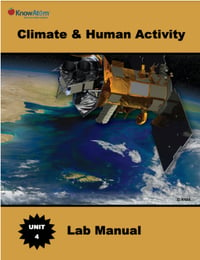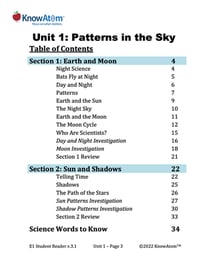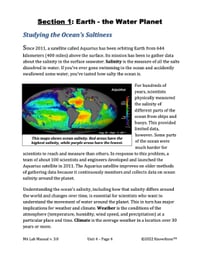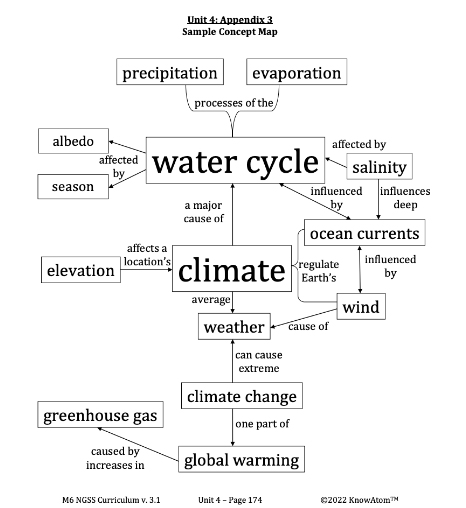Once students understand how water moves around the planet and the role of the oceans in the water cycle, they focus, in this lesson, on regional climates, figuring out the factors that influence a location’s climate.
In this unit, students build on their scientific knowledge about matter, energy, and heat transfer to explore science phenomena related to weather and climate. They investigate how the sun powers the global water cycle, which in turn has very local impacts that affect the phenomena of regional climates around the world. This page showcases all the parts of this lesson.
The science background section gives teachers more in-depth information on the phenomena students explore in this unit. Below is an excerpt from the lesson on Earth’s climate.
The same scientific principles that power deep ocean currents also distribute heat around the planet in the atmosphere. Warm air, which is less dense than cold air, rises. Then cool air moves in and replaces the rising warm air. This movement of air is what causes wind, and it moves heat from the warm equatorial regions to higher latitudes and from Earth’s surface upward into the atmosphere.
All wind is caused by the same process that powers deep ocean currents. Air moves from high-pressure to low-pressure areas, similar to how high-pressure air rushes from the mouth of an inflated balloon when you let go. As air is heated, its density decreases as its molecules spread out and move up. As air cools, its density increases, causing it to sink. There are two categories of wind: local winds and global winds. Local winds travel over very short distances, and can change often. Sea breezes and mountain breezes are both examples of local winds.
Global winds are large air masses. An air mass is a large body of air that has a similar temperature and humidity throughout. Global winds move around the entire planet, and they are created by Earth’s rotation, Earth’s shape, and the uneven heating of Earth’s surface.
In the Northern Hemisphere, the sun warms the air around the equator. That warm air rises and flows toward the North Pole as heat moves from the warm region to cooler regions. However, because Earth rotates around its axis, the air doesn’t travel in a straight line. Instead, it is pushed into curved paths. This is called the Coriolis effect. Because of the Coriolis effect, the warm air in the Northern Hemisphere is pushed to the right (northeast). A similar wind pattern happens in the Southern Hemisphere but opposite. Because of the Coriolis effect, the warm air is pushed to the left (southeast). Because these winds blow from the west to the east in both hemispheres, they are called westerlies.
The trade winds are the prevailing wind pattern within the tropical region on Earth. These winds blow from the north toward the equator in the northern hemisphere and from the south toward the equator in the southern hemisphere. Trade winds blow from east to west in both hemispheres, and they are responsible for pushing hurricanes from east to west.
The global winds, both the trade winds and the westerlies, also push against the ocean’s surface. This causes surface ocean currents to move to the right in the Northern Hemisphere in a clockwise spiral and to the left in the Southern Hemisphere in a counter-clockwise spiral. The ocean currents are also affected by the outlines of Earth’s continents as they transport heat from the equator to the poles.
Scientists use satellites to provide evidence that water is constantly in motion, in water vapor and in ocean currents. The movement of ocean and air currents, transporting heat from the warm equator to the chilly poles, is significant because the transfer of heat around the planet regulates Earth’s climate. Without it, regions near the equator would be much hotter while regions near the poles would be much colder.
Once students understand how water moves around the planet and the role of the oceans in the water cycle, they focus, in this lesson, on regional climates, figuring out the factors that influence a location’s climate.

Prepared hands-on materials, full year grade-specific curriculum, and personalized live professional development designed to support mastery of current state science standards.
Elevation : the height of a location above sea level
Wind : moving air

Analyzing Earth from Space
One day in July 2005, far above Earth’s surface, a satellite named Aqua was collecting data on the complex interactions that drive the water cycle, focusing on interactions between the energy produced by the sun and water on Earth.
From its perch in space, Aqua gathers information about evaporation from the oceans, water vapor in the atmosphere, clouds, precipitation, soil moisture, sea ice, land ice, and snow cover on the land and ice.
One area where it was gathering data was Cape Verde, a group of 10 islands near the equator. In July 2005, temperatures were very high. Aqua recorded the moment when the ocean’s surface reached a critical temperature—27 degrees Celsius (80 degrees Fahrenheit). At this temperature, ocean water begins to evaporate. Aqua collected data showing that millions of tons of water vapor evaporated from the ocean every hour.
Scientists could then track the movement of that water—and the resulting weather it caused—around the planet. The data from the satellites provide evidence that water is constantly in motion, in water vapor and in ocean currents. The warm ocean water and water vapor produced at the equator continually carry the sun’s energy toward the poles. This is significant because the transfer of heat around the planet regulates Earth’s climate. Without it, regions near the equator would be much hotter, while regions near the poles would be much colder.
Global Patterns, Local Climate
As ocean and air currents carry heat, they influence the climate of the land. The Gulf Stream offers a good example of how the water, air, and land interact to influence climate. The Gulf Stream is an ocean current that flows eastward from the Gulf of Mexico, around the southern tip of Florida, and along the East Coast up to Iceland and Norway. It is like a warm river that moves over and through the colder waters of the Atlantic Ocean.
As it travels north, the warm water in the Gulf Stream cools off because of evaporation caused by wind moving over the water. That evaporation results in water that is saltier and denser. By the time the water reaches the North Atlantic Ocean, the water is so dense that it begins to sink down through less salty and less dense water. Here, it joins another current that moves south, toward warmer, less-dense water, continuing the cycling of water around the planet.
Florida’s climate is influenced by the Gulf Stream, as well as the state’s location relative to the equator. Remember that different parts of Earth receive different amounts of sunlight because of Earth’s tilt. Regions that are closest to the equator receive the most direct sunlight and so have the warmest temperatures. Regions that are closest to the poles receive the least amount of direct sunlight and so have the coolest temperatures.
Scientists measure a location’s position relative to the equator as its latitude. The equator’s latitude is 0 degrees, while the poles’ latitude is 90 degrees. South Florida has a latitude of around 26 degrees north of the equator (26N).
In addition to its latitude, South Florida’s climate is also affected by its location next to the warm ocean water. The ocean has the effect of keeping temperatures warmer in the winter and cooler in the summer than other southeastern states. This results in what scientists call a marine climate.
This is because of how heat always moves from warmer regions to cooler regions seeking equilibrium. The ocean has a higher heat capacity than land. Heat capacity is the energy required to raise the temperature. In other words, it takes longer for water to heat and cool than the land.
Let’s think about South Florida again. South Florida (and all of the United States) is in the Northern Hemisphere. Summer occurs when the North Pole is tilted toward the sun. This causes temperatures to increase. As the sun heats Earth, the land becomes warmer before the ocean does because the ocean has a higher heat capacity. As a result, heat transfers from the warmer land and the air above the land to the cooler ocean. This transfer of energy (heat) from the land to the ocean causes the land’s temperature to decrease.
When it is winter in South Florida, the North Pole is tilted away from the sun. This causes temperatures to be lower. The land gets colder than the ocean, again because of the ocean’s heat capacity. Now, heat transfers in the opposite direction, from the ocean to the land. This causes the land to warm up more than it would without the ocean. In contrast, locations that aren’t near the ocean tend to have more extreme temperatures, both warmer and colder, because this heat transfer with the ocean doesn’t occur.


Effects of Landforms on Climate
Now imagine that you travel directly east or west from South Florida, but remain at the same latitude. You would quickly notice that the climate varies wildly. For example, the Himalaya Mountains are also located around 26N. However, it is not uncommon for temperatures to reach -37 degrees Celsius (-34.6 degrees Fahrenheit). This can be explained partly by their elevation, which is the height of a location above sea level. Areas at higher elevations generally have lower average temperatures than do areas at lower elevations.
This is because air pressure decreases as the altitude increases. At sea level, Earth's atmosphere is pressing against each square inch of you with a force of 1 kilogram per square centimeter (14.7 pounds per square inch). The higher the pressure of a gas such as air is, the more thermal energy it has. Low air pressure makes the atmosphere less able to absorb and retain heat. Therefore, as you climb higher, air temperature decreases. Typically, air temperatures decrease about -16 degrees Celsius (3.2 degrees Fahrenheit) per 1,000 feet of elevation.
Also at 26N lies a city in India, Cherrapunji, that has a semi-tropical climate. It also has the world record for most rainfall in a year—26,461 millimeters (1,042 inches). This record amount of rain occurs because of interactions between the water cycle and the geography of the region.
The rains that fall on Cherrapunji begin in the Bay of Bengal. Just like the water cycle happening all over the planet, the ocean water is heated by the sun, causing water vapor to evaporate into the atmosphere. As it evaporates, it carries heat with it. As it rises, the water vapor condenses, transferring heat to the air and becoming liquid water again as it forms clouds. Those clouds move over the country of Bangladesh, which is mostly plains (relatively flat land). Because there are no large hills or other barriers, the clouds move straight through.
Then, the clouds run into a mountain range called the Khasi Hills, which rise above the plains. These hills have valleys between them, and wind pushes the clouds through the valleys and up the steep slopes. As the clouds rise higher, condensation continues as the water molecules continue to transfer heat to the atmosphere. This results in the extreme rainfall over Cherrapunji. The land on the other side of the hills receives much less rainfall because the clouds carrying the rain rarely move past the Khasi Hills.
As the main investigative phenomena in this lesson, students analyze and compare regional climate data in different cities to explain why each city experiences such differences in climate phenomena. Students investigate various factors that influence the climate in each city. Factors include latitude, proximity to the ocean, elevation, and land geography.
KnowAtom incorporates formative and summative assessments designed to make students thinking visible for deeper student-centered learning.

Standards citation: NGSS Lead States. 2013. Next Generation Science Standards: For States, By States. Washington, DC: The National Academies Press. Neither WestEd nor the lead states and partners that developed the Next Generation Science Standards were involved in the production of this product, and do not endorse it.
